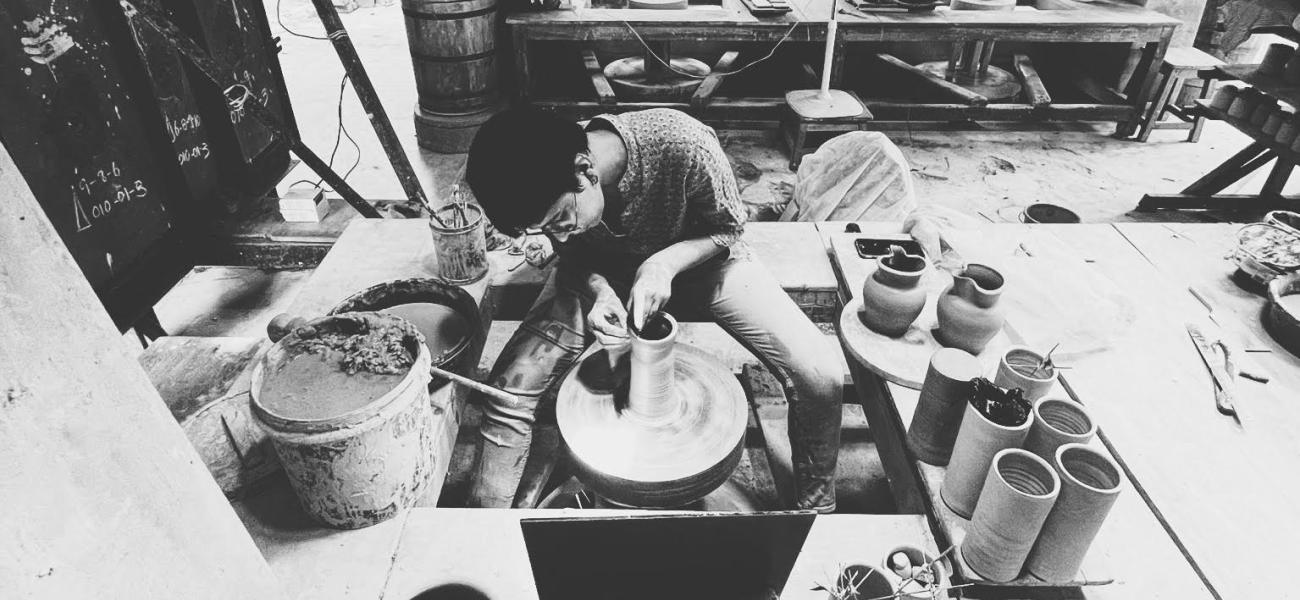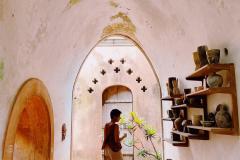Everything in Between
Growing up in India meant a lot of things – little nostalgic and precious memories – that your heart returns to again and again with moments that matter. As a kid and now, I love spending time in the kitchen. Yes, cooking, but more importantly, being around people, assisting, selecting vessels, and everything in between. Spending time in the kitchen is a warm act, full of life and conversations, and holds a great deal of importance in an Indian household. I remember my mom telling me, humorously, how as a kid, I was picky about my favorite set of plates, bowls, and spoons and it had to be the specific ones or nothing.
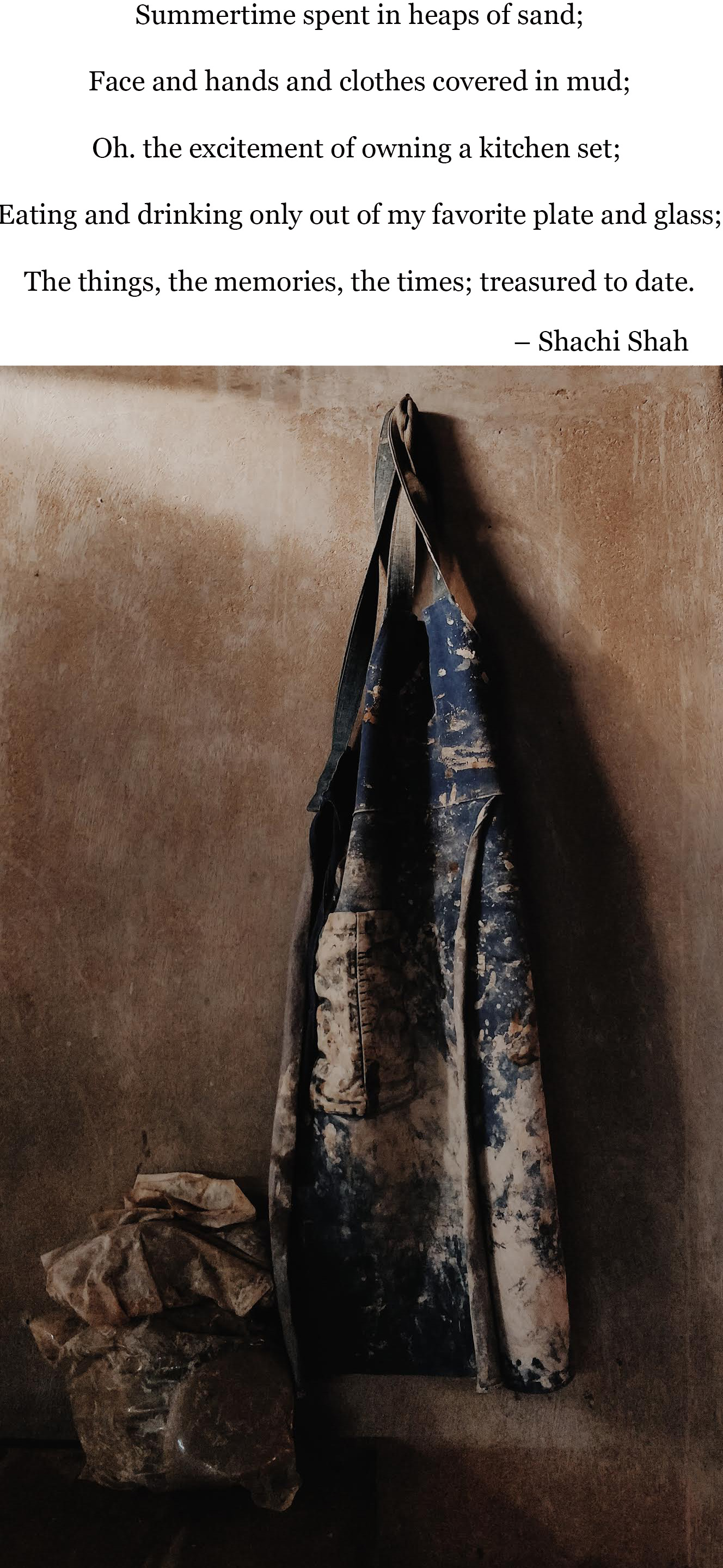
I have been lucky to be surrounded by siblings who pursued art and design; I think it had an unknown but significant influence on me. Time flew by, and I grew up without attending an art or design school. I pursued liberal studies, majoring in marketing and mass communication. I spent four years learning diverse subjects like Japanese, theater, and art history, as well as journalism and some math. All this time, the inner voice kept telling me to give my interest in art a chance. It began with an up-cycling project where I painted glass bottles that would usually go to waste otherwise. Later, I explored digital illustrations, which I printed into posters and cards.
It was only when I graduated in 2020 that I gave serious thought to my inner voice. Pottery has always been an activity on my bucket list. With no scope for traveling due to the pandemic, I decided to take pottery lessons from a studio potter and an architect, Naomy Parikh, at Doro, a collaborative practice in my hometown, in the western city of Ahmedabad India. "Trim your nails and be here at 7:00 a.m.," she said. That is how and where it all began.
I spent six months here learning the basics: how the clay feels, wedging, centering, pulling cylinders, reclaiming clay, and everything in between. The time I spent at Doro was a little peek into the world of clay. The setup was simple: a home studio, an electric wheel tucked in one corner, a table I used to wedge clay on, and that's about it. It was all about making the most of what I got at that moment, and I am glad to have started this way. The place, the people, and the energy kept me going. It started to mean a little more than just a hobby class; I spent more than eight and sometimes ten hours a day there. I started enjoying the struggle and the challenges that clay gave me every passing day; it did it for me. These months were only about learning how to throw, cross-section, and reclaim. These were the initial lessons in detachment and letting go.
Having graduated with marketing and mass communication and worked as a social media manager for a couple of years, I knew this would be a huge jump. While stuck in the middle of a pandemic, I was fortunate enough to have the headspace and time to ponder over life and career decisions. It was an excellent time to take a step back and reconsider.
This period was a mixed soup of emotions; that feeling of having butterflies in the stomach felt real: anxiety, uncertainty, risks, and excitement.
A couple of months later, I signed up for the seven-month course at the Golden Bridge Pottery (GBP) in Pondicherry, not knowing what it would have in store for me. It took a little convincing at home, but my parents have been supportive, and I appreciate their approval. That being said, I arrived on April 2, 2021, in this quaint little French town, Pondicherry, on the southeast coast of India, the home of Sri Aurobindo Ashram. With a rich history spanning half a century, GBP is a living example of a program that continually bringings beauty to this world. Founded in 1971 by Ray Meeker and Deborah Smith (Debbie), GBP created a significant impact on contemporary Indian ceramics. Nothing describes their journey, the history, and the pottery better than Ray Meeker's book, Building with Fire.
The GBP began as a single coconut-leaf shed on barren land. Over the years, the pottery expanded, shed after shed, hosting artists worldwide. The pottery required no power and sustained itself even as production expanded. GBP ran without major electricity consumption for the longest time: kick wheels, clay slaked and sieved into terracotta drying tanks, and natural-draft kilns. Everything is done by hand; it was and still is an immersive lifestyle. Void of motorized and electrical sounds, one is transported to another world when they enter a vast open space. With trees all around and birds chirping, there is a sudden sense of calmness.
April 5, 2021 – I brimmed with excitement as I walked into the gates, welcomed by stacks of wood and the classic Ayyanar Horses by Edappadi K Palaniswami. We gathered around the tea spot for a quick meet-and-greet. We were a group of ten women who belonged to a diverse age group, with me being the youngest at twenty-two-years-old and the other women's ages ranging from their thirties to their sixties. Coming from different walks of life, our lives bonded over pounding and weighing sacks of clay. We were to prepare all of the clay for the entirety of the course - almost 160 kg (352 lbs). We split ourselves into teams; we endearingly and humorously called ours "the dream team." From the pounding, slaking, sieving tank to tank, and making a hump of clay to packing it into bags for use, the entire process took twelve to fifteen days. From the very first day, we were enveloped in clay. Everything from removing the slurry from one tank to sieving it into the other was done manually, bucket after bucket. The physical toll was demanding; our backs ached, but there was something satisfying about the mindful activity. The whole process took every bit of us, and it was rather fulfilling in some ways. I enjoyed the rigor.
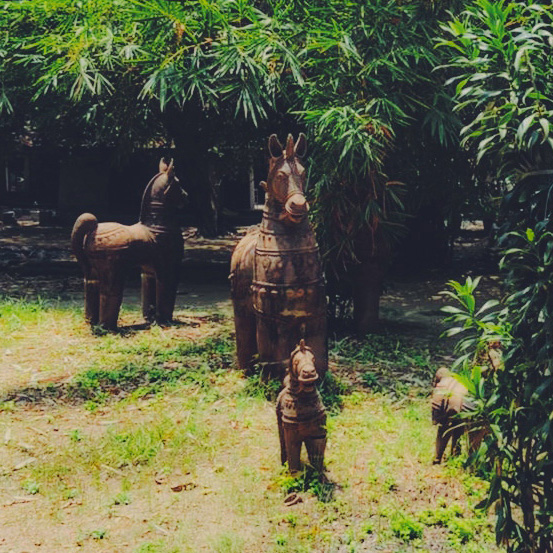
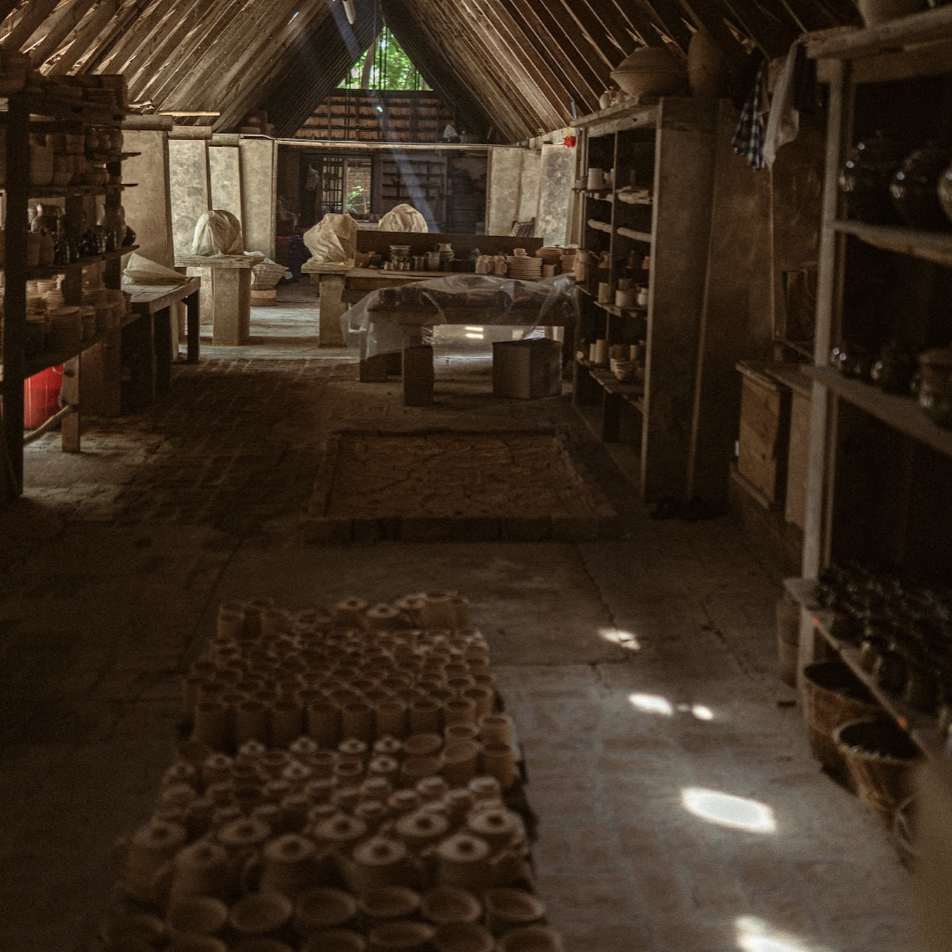
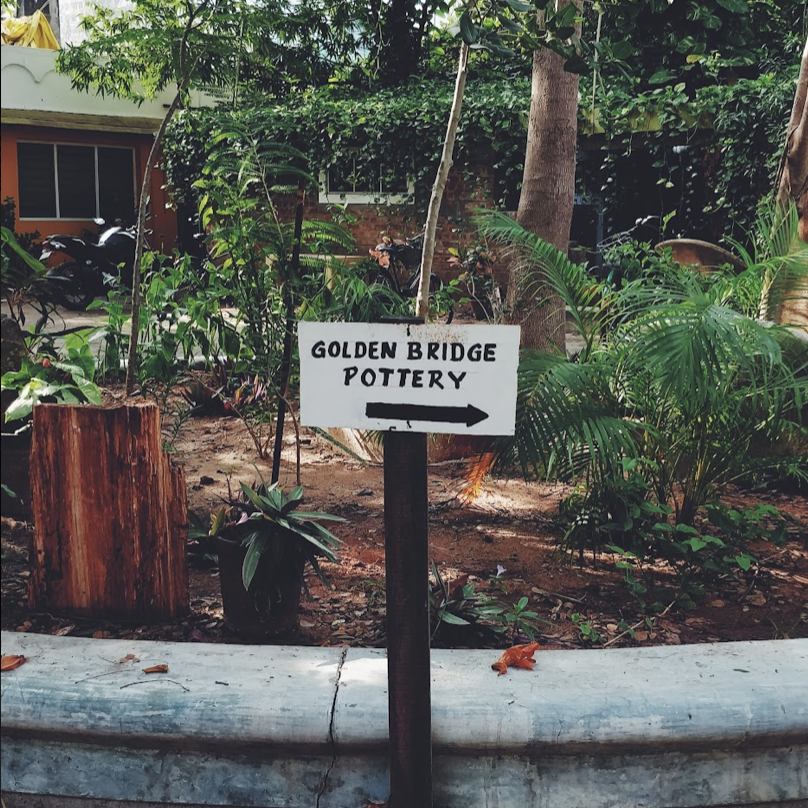
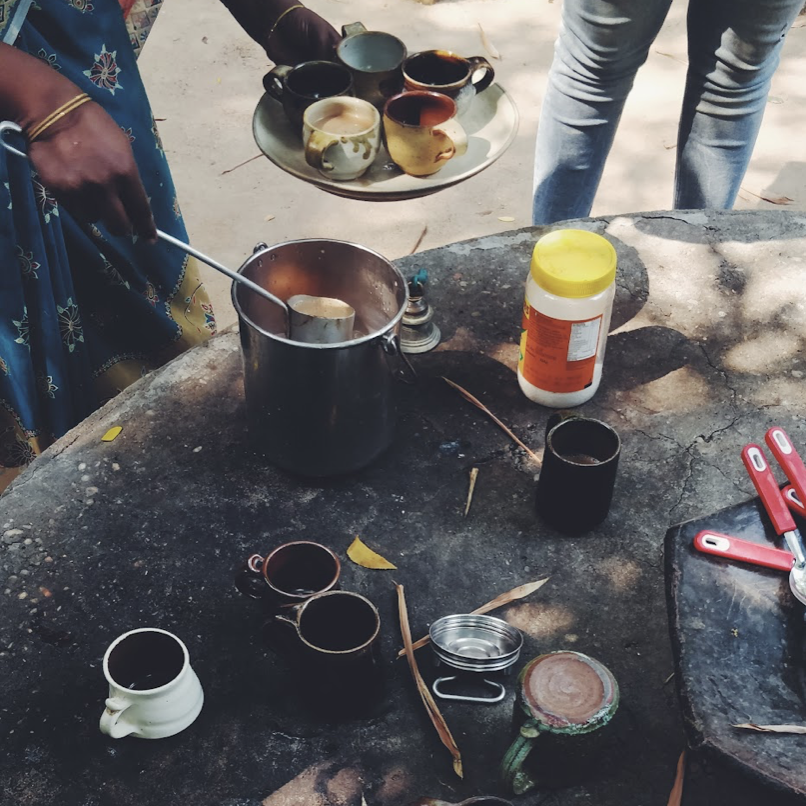
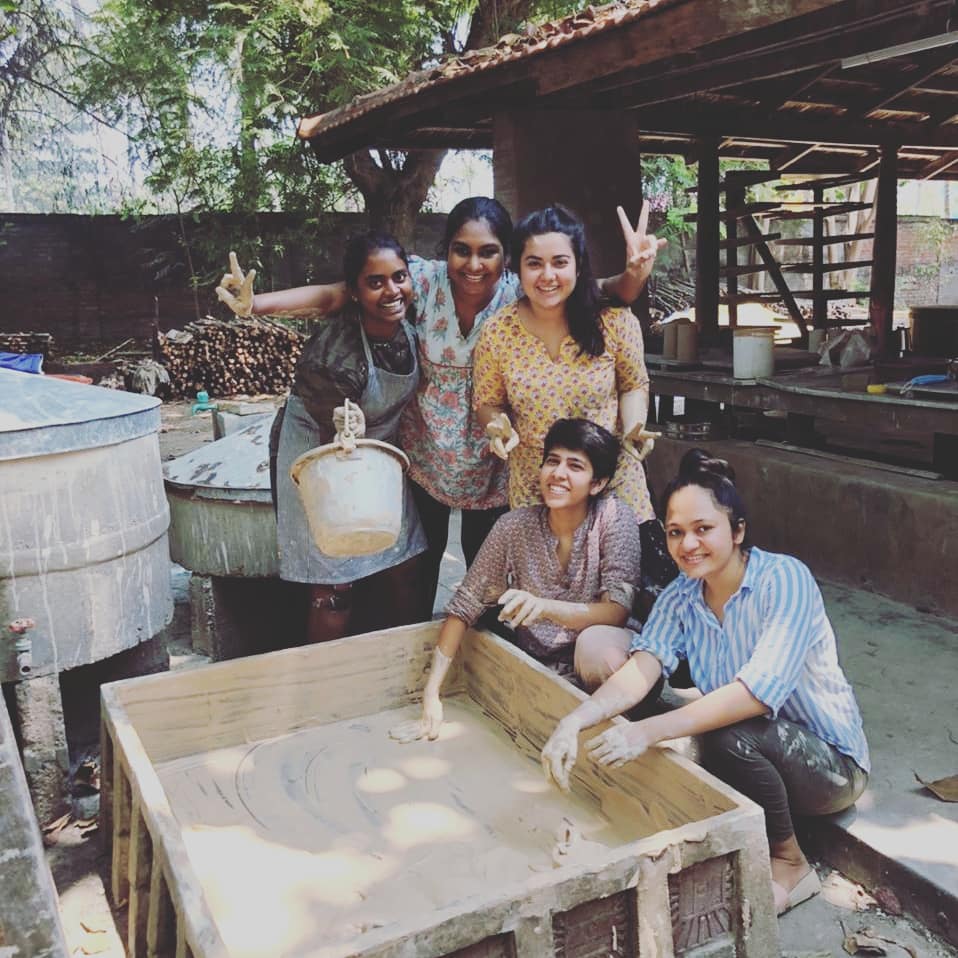
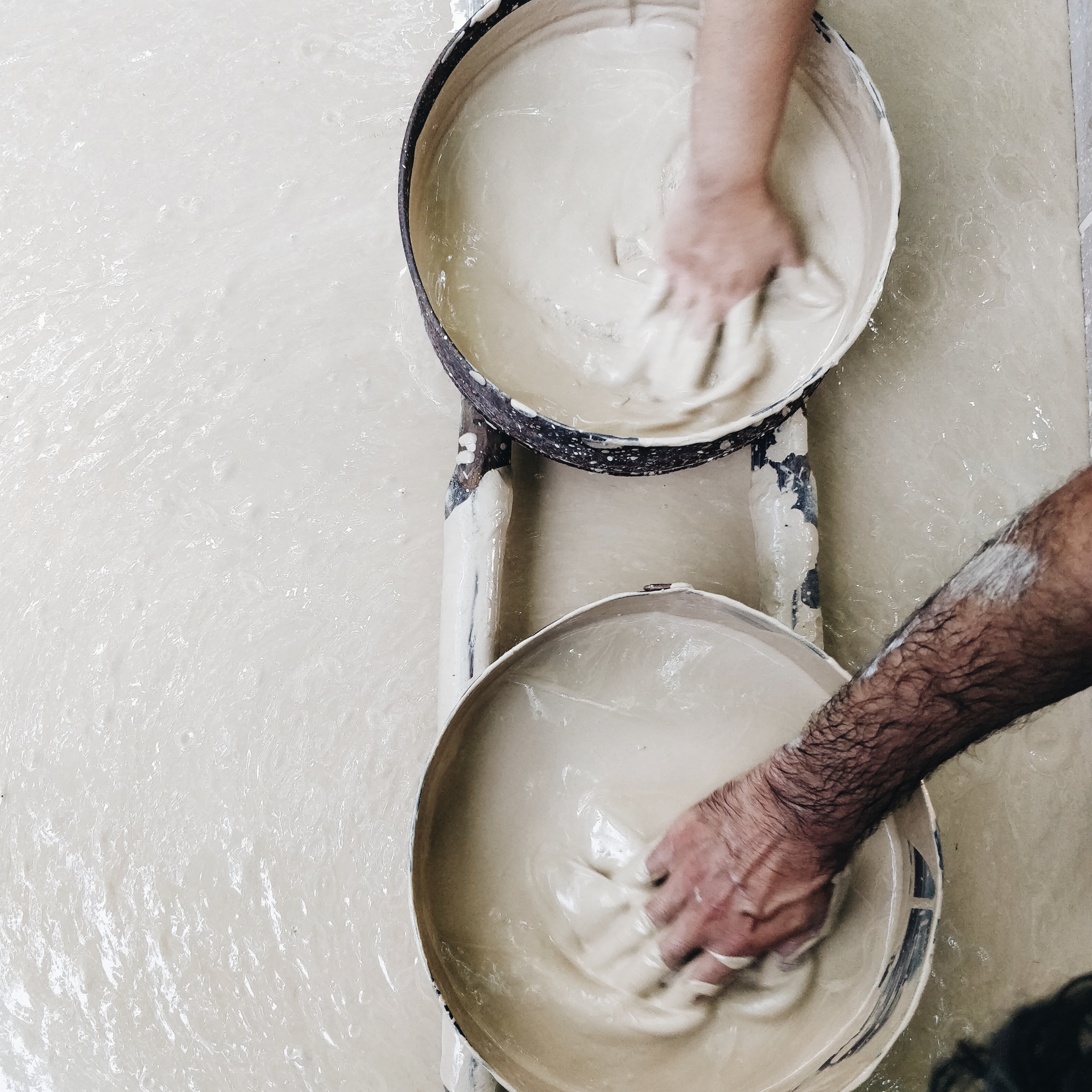
This came with learning how to manage our studio time. We spent early mornings or evenings making clay, because it got sweltering during the day, and the other midday quiet hours on the wheel. A typical workday began at 8:00 a.m. with gathering tools, wedging kilos of clay for the day, arranging fresh flowers in this small pot near my wheel, and finally plonking clay on the wheel to center. The day ended around 5:00 p.m., some days later. It took me a week or so to get used to the manual Korean-style kickwheel. Centering using a manual wheel felt the most alien. It was like starting from scratch all over again – learning to unlearn. Working on a kick wheel requires getting your mind, body, and hands in sync with the rhythm of the kicking and vice versa. As technical as it sounds, it is only about getting used to it.
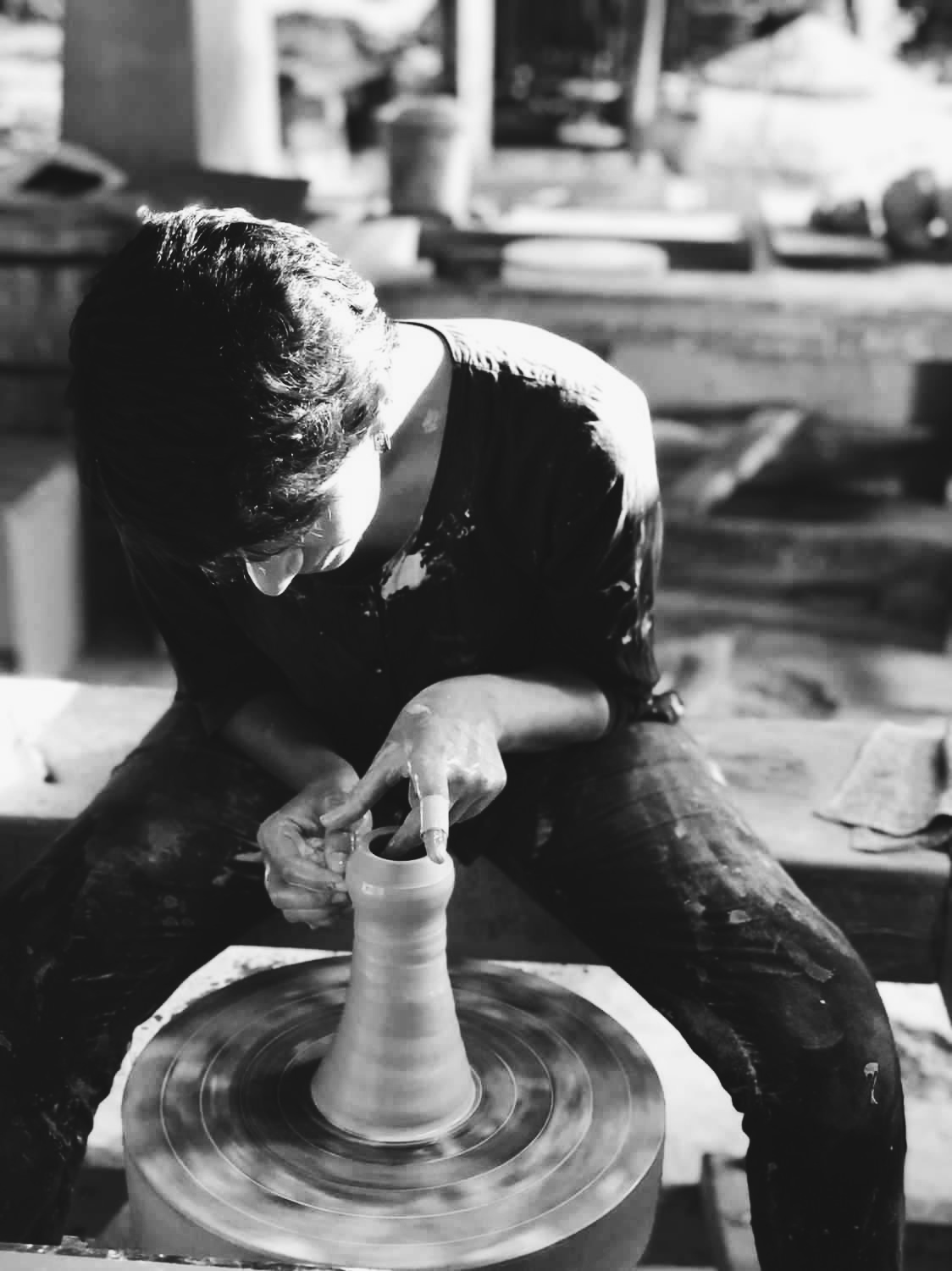 A couple of days later, after having fun with clay, came our first assignment from my mentor, Aarti Manik. "500 grams of clay, twenty cylinders a day, and repeat," she said. Though this felt impossible for a beginner, I gradually managed to throw ten a day. It wasn't easy. Some days went by only trying to center, some barely managing to pull. There were good days as well, especially when one of the many thrown vessels had even walls; it felt like an accomplishment. The end of the day called for a review of pots, which meant cross-sections. This critique came with some hesitation, but soon enough, we got into the habit of cutting pots and got a step closer to learning the art of detachment. A month passed by, and the second wave of COVID-19 came. Pondicherry issued strict guidelines and curfew norms. The curfew began at 2:00 p.m., which meant shorter working hours. We started in the morning, around 6:00 a.m., and tried to get back before curfew. It disrupted our schedules, as we had just gotten into the groove. We spent four weeks this way until certain relaxations were announced.
A couple of days later, after having fun with clay, came our first assignment from my mentor, Aarti Manik. "500 grams of clay, twenty cylinders a day, and repeat," she said. Though this felt impossible for a beginner, I gradually managed to throw ten a day. It wasn't easy. Some days went by only trying to center, some barely managing to pull. There were good days as well, especially when one of the many thrown vessels had even walls; it felt like an accomplishment. The end of the day called for a review of pots, which meant cross-sections. This critique came with some hesitation, but soon enough, we got into the habit of cutting pots and got a step closer to learning the art of detachment. A month passed by, and the second wave of COVID-19 came. Pondicherry issued strict guidelines and curfew norms. The curfew began at 2:00 p.m., which meant shorter working hours. We started in the morning, around 6:00 a.m., and tried to get back before curfew. It disrupted our schedules, as we had just gotten into the groove. We spent four weeks this way until certain relaxations were announced.
Having gone to school and college in India, I was exposed to and trained in a formal setting. However, GB was quite different. I remember reading in the course prospectus, "It is not a hobby course. And it is
not an 'art school'," in those very bold letters. The course was far from an institutional one. Aarti would usually give us a demo of a form every Monday morning, which we followed, and mirrored for the rest of the week. We used to gather in her studio to watch and observe her throw on her wheel. We studied each piece and rushed back to our wheels to practice the same. We took notes, drew sketches, and did whatever helped us understand the form. She would then come for a round, sometimes twice daily, to check our progress and give critiques. She would also watch us throw and point out where we went wrong, but we weren't spoonfed; we were left to problem-solve by ourselves most of the time, being our own critics. The more time we spent with clay, the more answers we discovered. I liked how she paid attention to the fact that we kept reading and researching. This habit has stayed with me to date. When she spoke about her time as an apprentice and the experiences she gained with different firings and participating in workshops over the years, it was quite insightful and inspiring. I used to look forward to these story-telling sessions. Most of the time, this happened when we all gathered for tea. We learned a lot from pots; she showed us her collections and pots from her firings, and we also used to go around the pottery to look at the production pots. She taught us how to be one with clay rather than fighting it, to remember that clay has memory and there was no way one could salvage it. We all warmed up over time, and she became more like a friend to all of us. We cooked together, spent time at the beach, and went out for hearty meals. It's been authentic, deep, and genuine learning this way.
Cylinders led to tapered forms, on which we learned handling – attaching handles – and, more humorously, "mishandling." I remember it taking us forever to truly understand the form – the angle of the taper. I realized we were training the eye to look at the structure and visually understand the proportions first. I became more at ease with clay as I progressed from one form to the next. The best part about the course was that it progressed at the student's pace. Some of us chose to go back and practice old forms, and some moved on to the next. The course was quite mindfully designed. We went from straight to slightly bellied to round forms, and at last, the teapots.
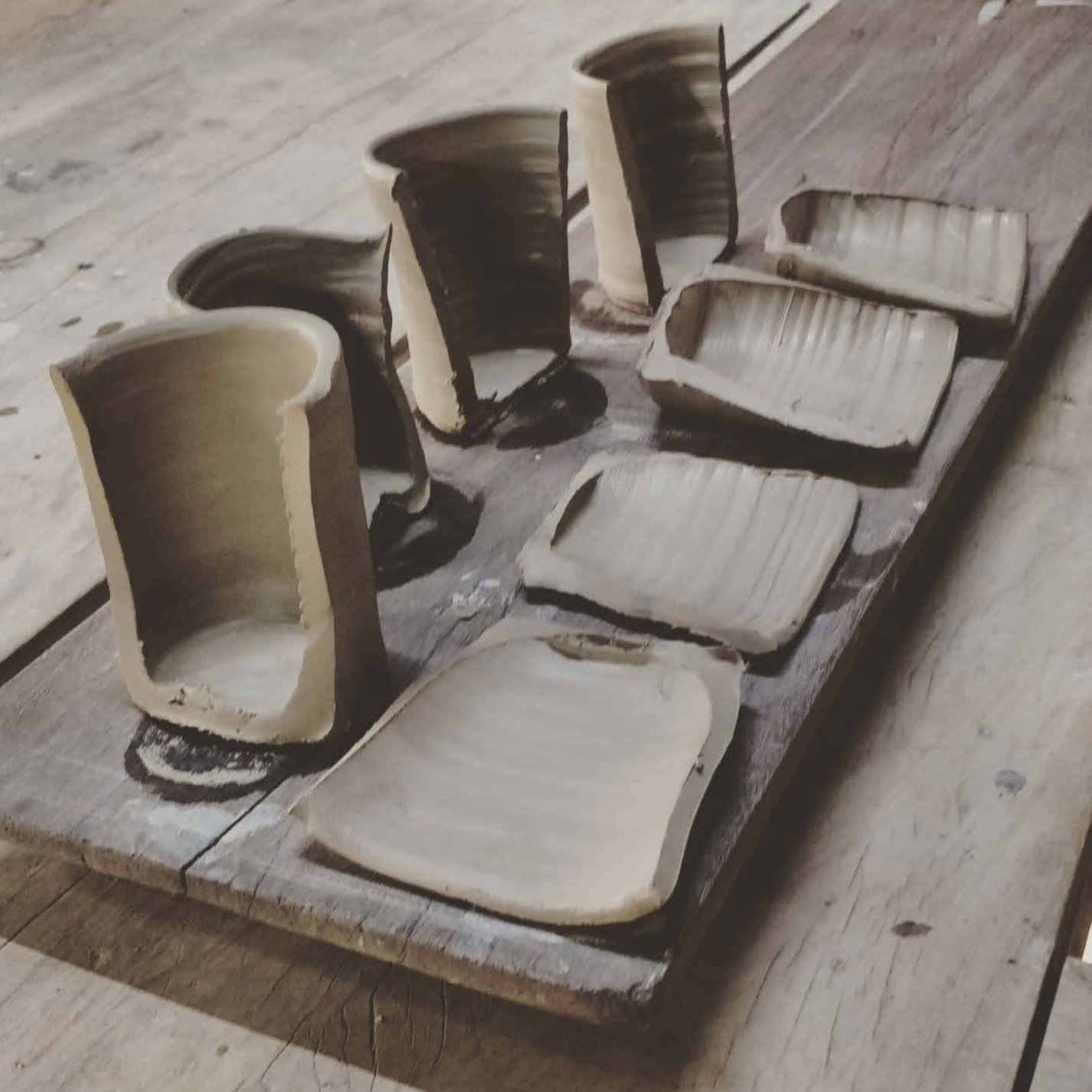
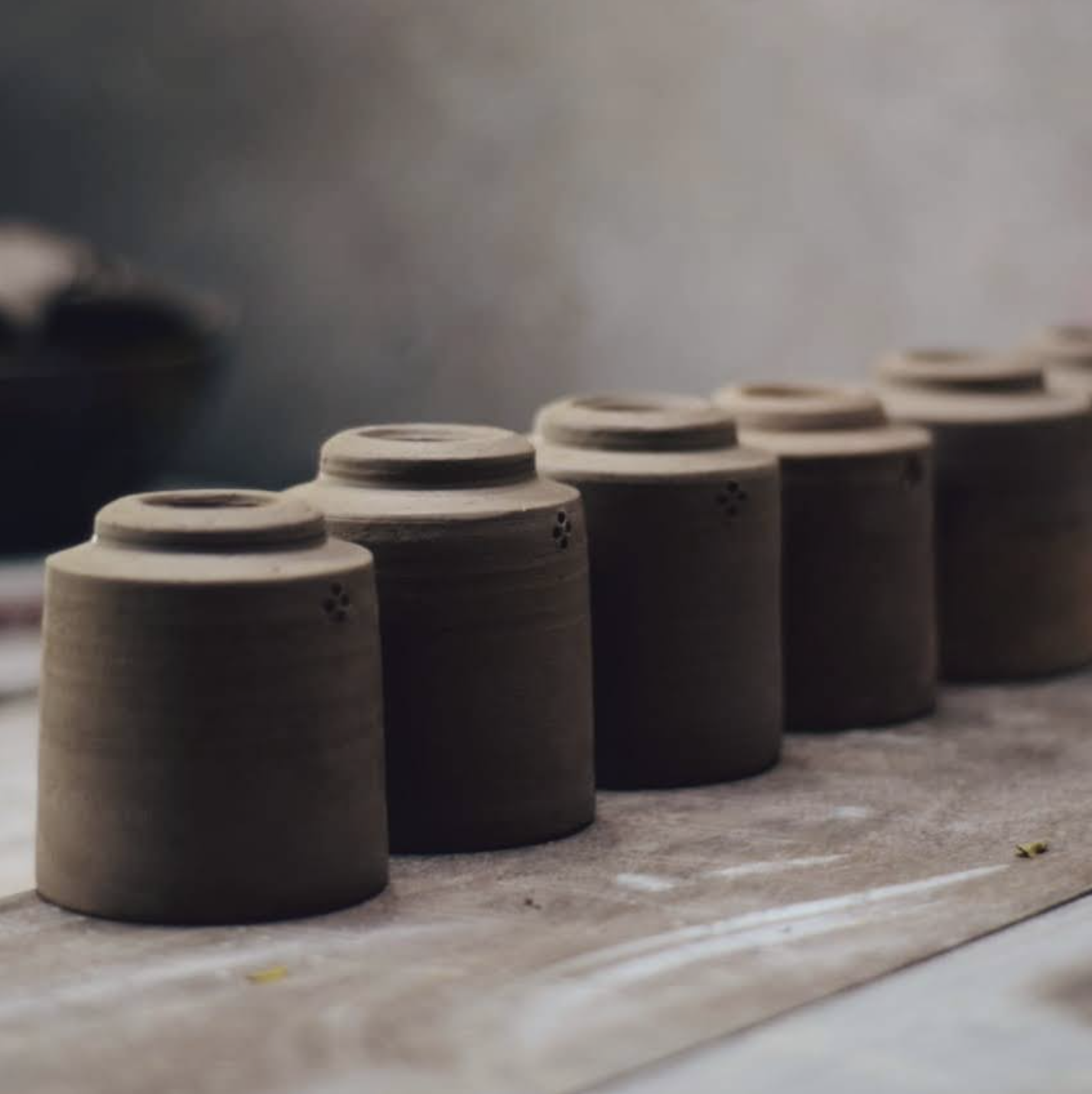
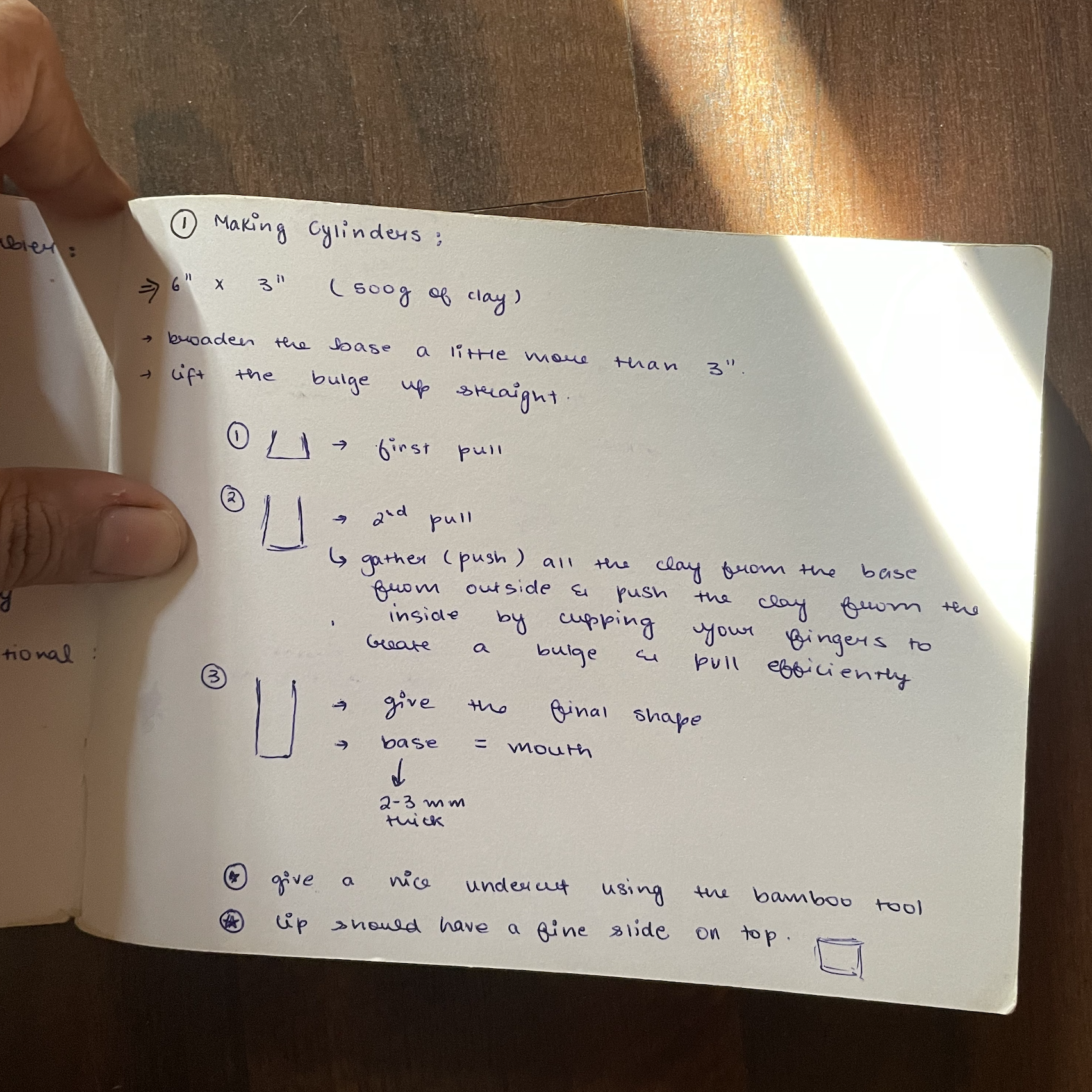

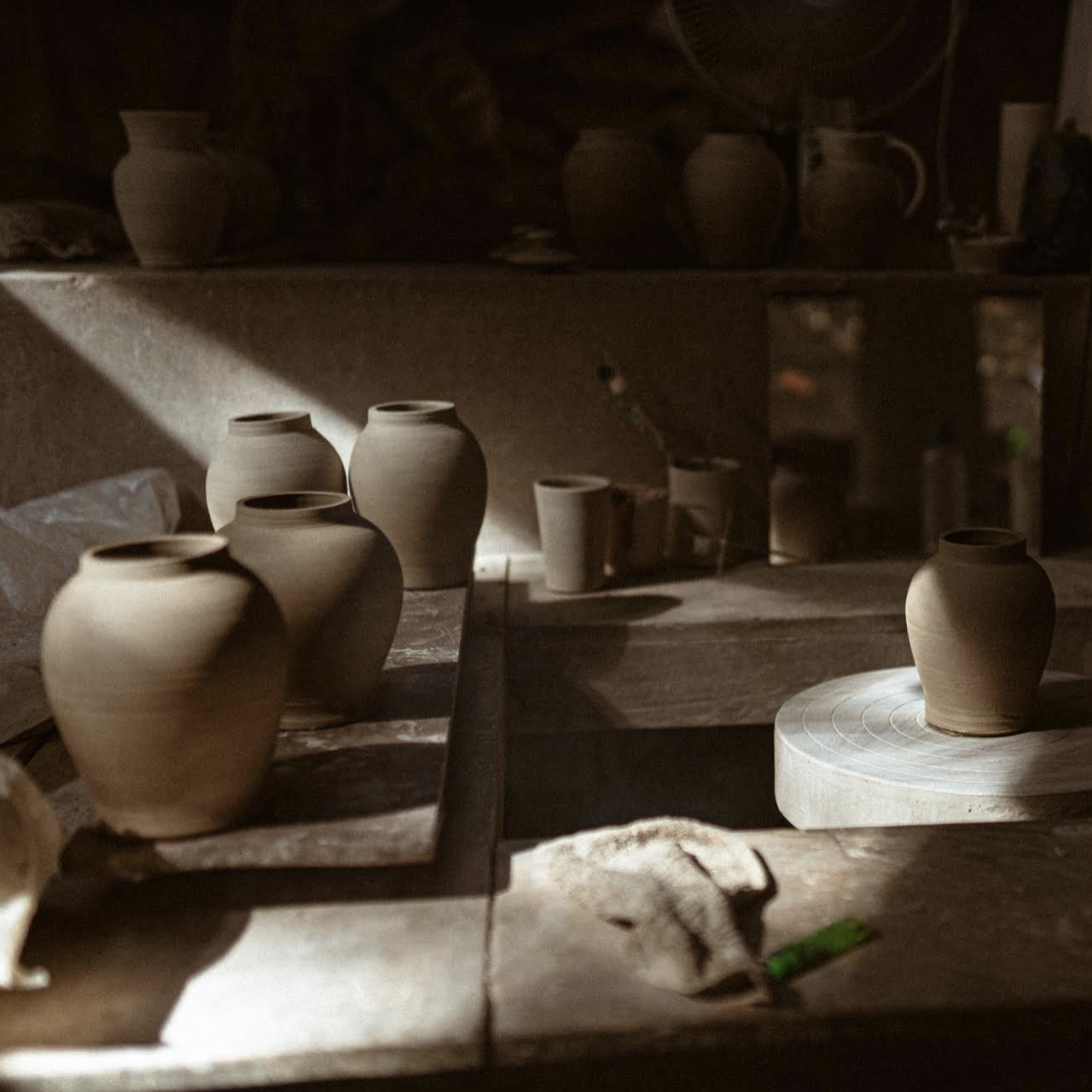
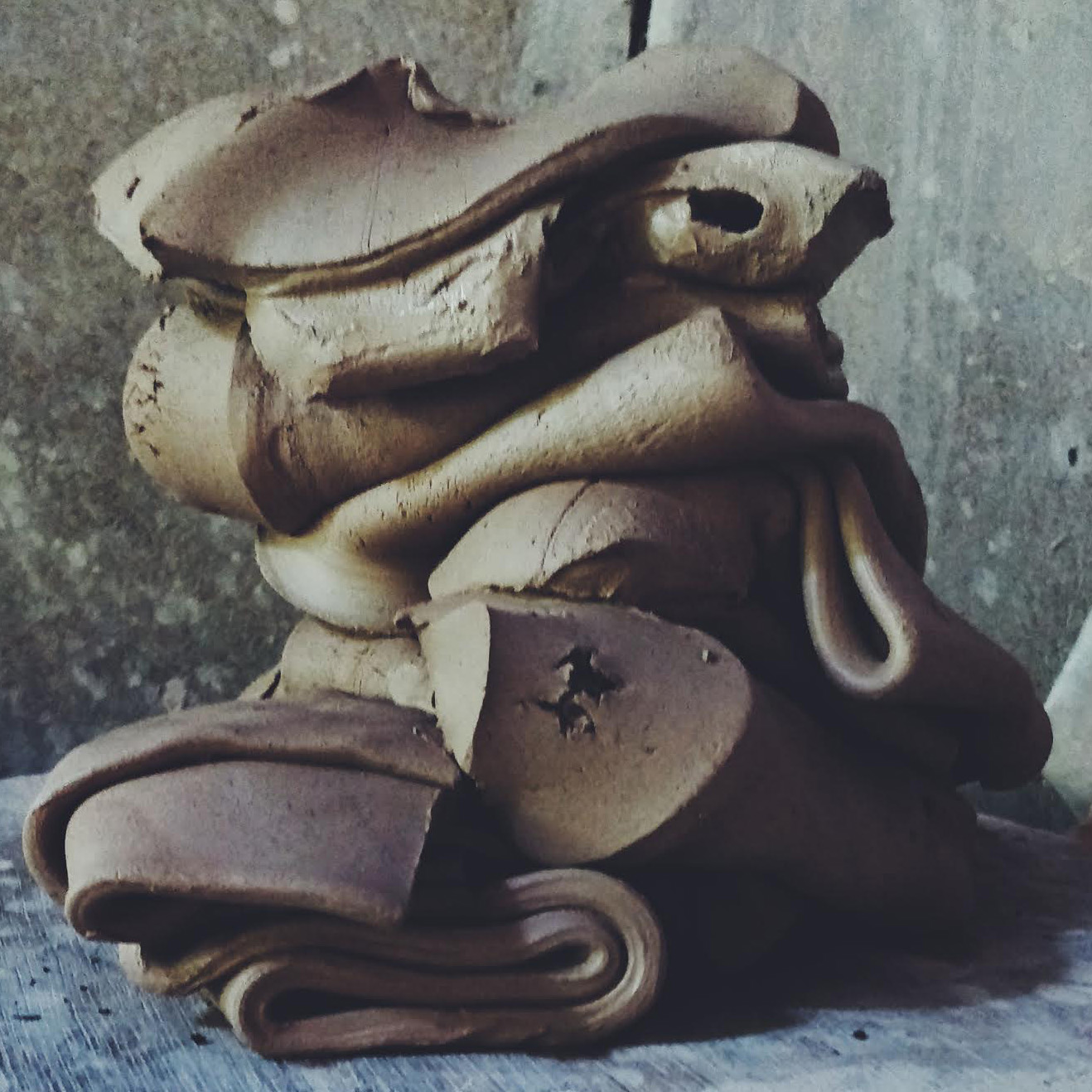
There were days of struggles that broke me down sometimes, but I kept telling myself – rather, reminding myself – what I was here for was to learn, to grow, and to appreciate the journey. Every day was a new experience. I learned daily from clay, my peers, the staff (Annas' and Akkas' - In the Tamil language, the informal endearment to address a brother is Anna, and Akka refers to a sister), my mentor, and everyone around me. Observing Annas' and Akkas' work for the pottery's production was a great learning experience. Most of them have worked for GBP for over thirty to forty years and trained under Debbie. They're exceptionally skilled and efficient with what they do. They were family to us; their little inputs have been invaluable and have always helped me improve if I became stuck on a form or technique.
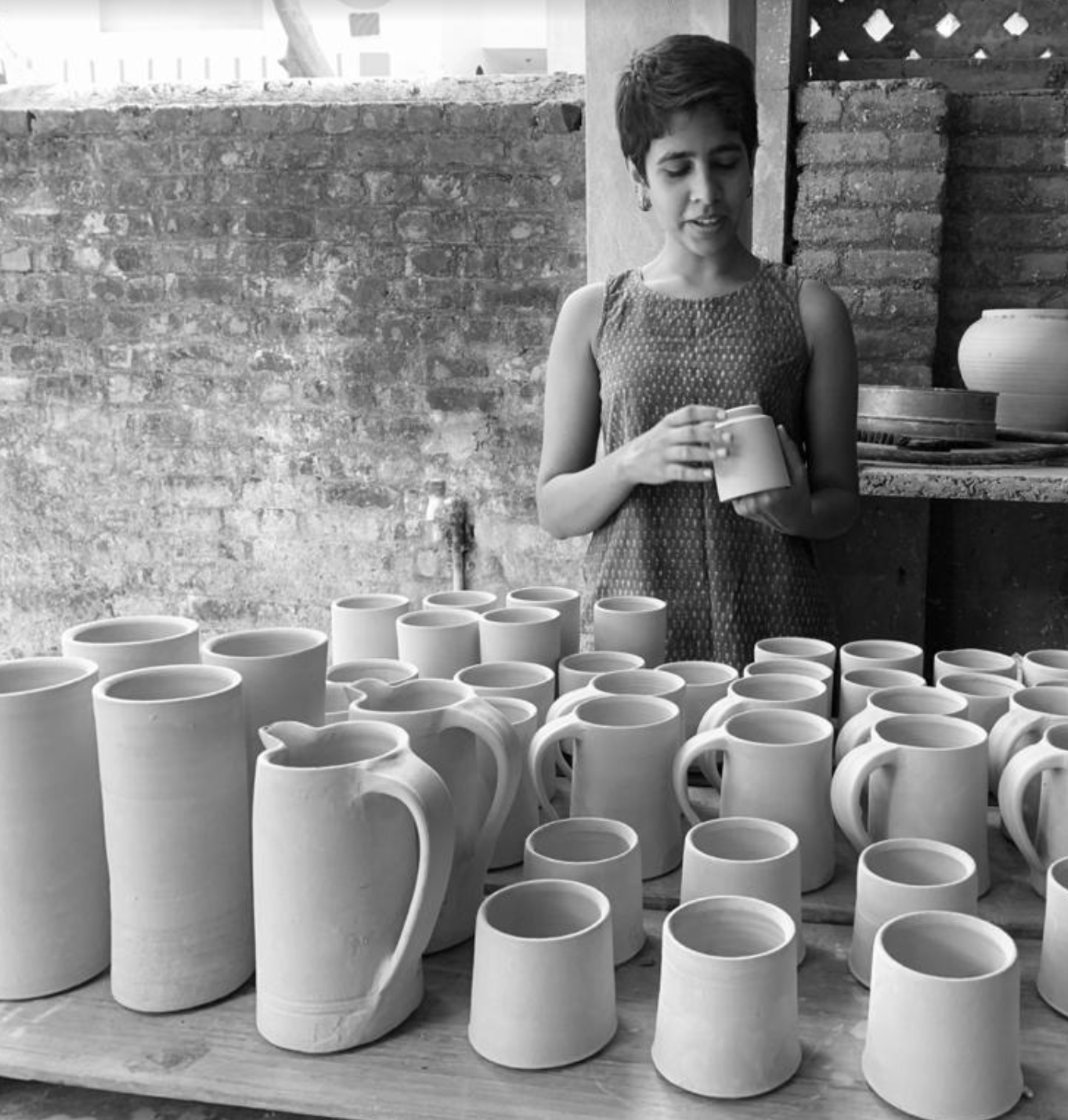 Our first wood-firing occurred three months later. We were set to fire the small downdraft wood-kiln called the "upma." The excitement came, and so did the nervousness about being able to fill the kiln. Aarti pushed us and our limits, and I am glad she did. We all put our heads down and tried to churn out as many pieces as we could, and in no time, we were geared up to load our gas kiln for our first bisque firing. The enthusiasm was genuine. We all took turns panicking every time the temperature dropped by a degree. Oh, how I enjoy the humor of reflecting on that moment. Aarti guided us with the firing, but we were to manage by ourselves for most parts. It helped us gain confidence, but we also goofed up at times. It was about learning from mistakes.
Our first wood-firing occurred three months later. We were set to fire the small downdraft wood-kiln called the "upma." The excitement came, and so did the nervousness about being able to fill the kiln. Aarti pushed us and our limits, and I am glad she did. We all put our heads down and tried to churn out as many pieces as we could, and in no time, we were geared up to load our gas kiln for our first bisque firing. The enthusiasm was genuine. We all took turns panicking every time the temperature dropped by a degree. Oh, how I enjoy the humor of reflecting on that moment. Aarti guided us with the firing, but we were to manage by ourselves for most parts. It helped us gain confidence, but we also goofed up at times. It was about learning from mistakes.
The pots came out blushing in pink. What followed were days of sanding, waxing, and cleaning our pots. We used the conventional waxing method, using beeswax and melting it on a stove fueled by kerosene. We had almost a week or a little more before our "upma firing." We all sat together for pre-loading or mock planning, trying to optimize as much space as possible. When we knew where our pots went, we started planning our glazes. Shifting wood, cleaning posts, and sieving glazes happened simultaneously. The whole studio had a different energy: people were running around trying to get things done, and there was lots of planning, coordination, and discussion. It was full of life and conversations, unlike the days we spent tucked in corners working on the wheel. While this entire process had been a great teamwork exercise, it was sometimes challenging. Quarrels and arguments were a part of it and were unavoidable; it was ten of us working together. Everybody had different schedules, ways of working, and opinions, but ultimately, it helped us come to solutions.
Part of me genuinely enjoyed glazing. Since it was my first time, I was a little shaky initially, but my confidence built up. The anxiety that came along while I dipped my first pot was real. I had approximately twenty-eight pots, mainly cylindrical forms, mugs, and yunomis. It was fun to learn and try different techniques. I was planning on paper and in my head about what I'd do with my pots. I played it safe but also gave myself some room to let loose and experiment. Soon came our day to load the wood-kiln. We all brought our glazed pots and laid them on the floor near the kiln. One by one, pot by pot, and shelf by shelf, we began and finished in no time. Brick by brick, the doors were packed.
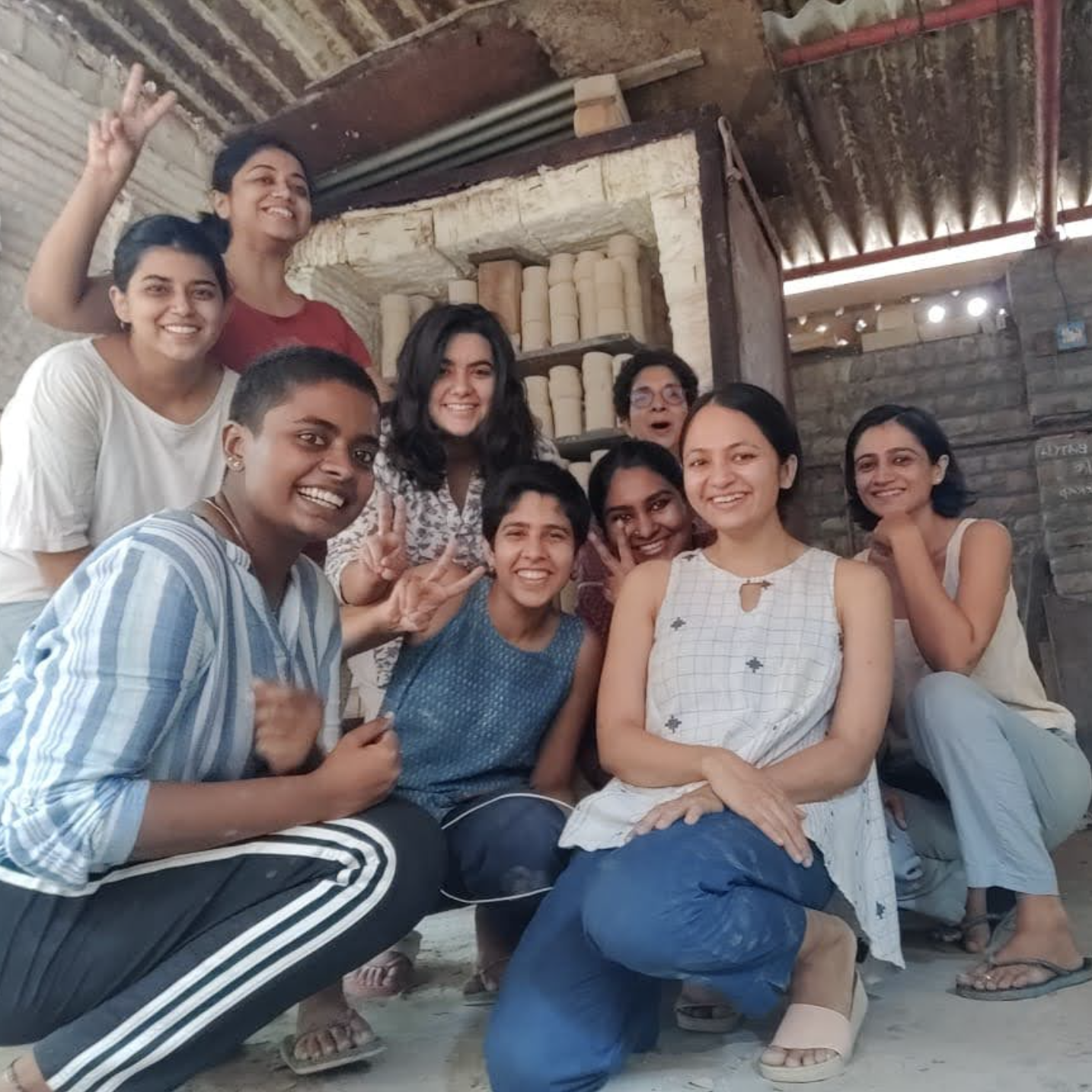
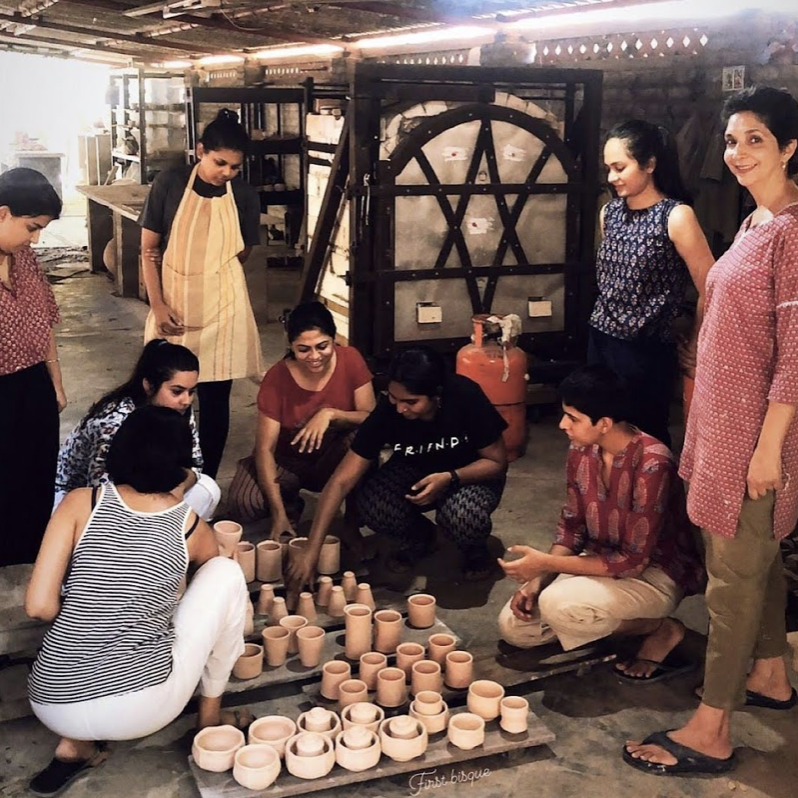
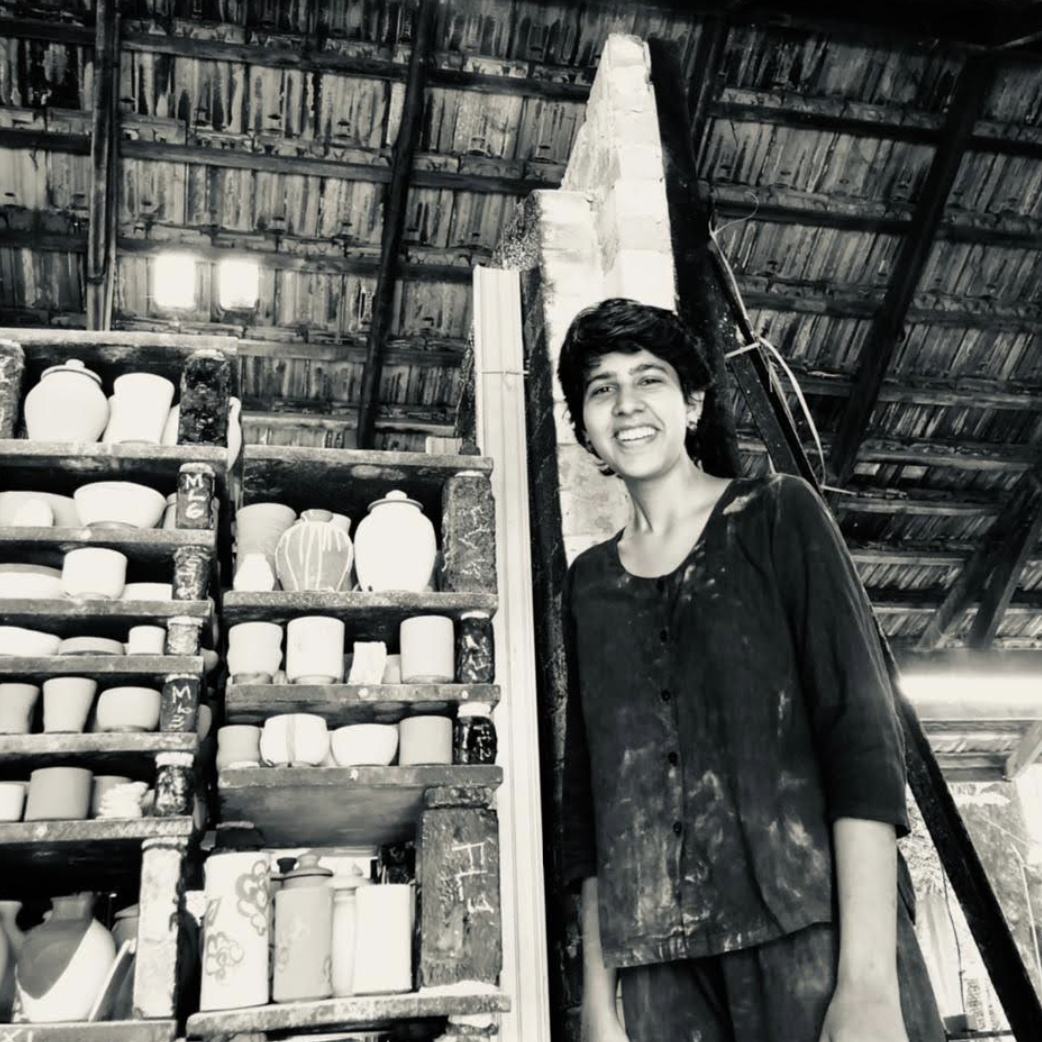
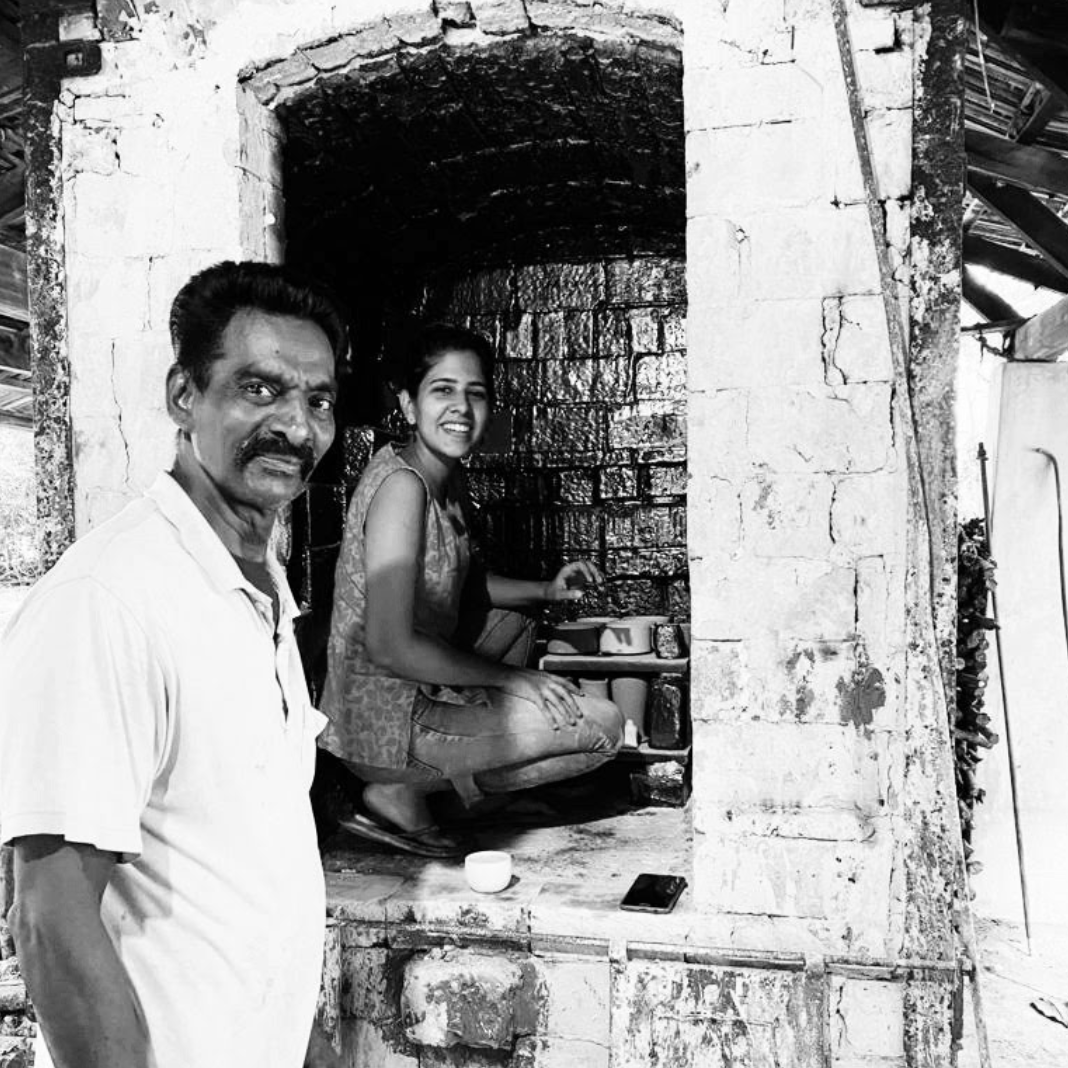
Firing schedule made, shifts decided, wood stacked and ready for hours of stoking; the day was here – one of the most awaited ones. We surrendered. I was feeling all kinds of things; there were layers of emotion that let my mind wander to the past. It was this sense of accomplishment when you look back and realize how far you've come. Though my mind wandered in reflection, in a jiffy, I was back in the present. While we were all brimming with questions, our mentor asked us to pay keen attention to the kiln, hear, observe the flames, and be present. We understood reduction this way, what happens when we push the damper in or pull it out, and how the heat travels. Though all the theoretical knowledge helped, I found this to be the most practical and hands-on way to learn. That quick peek into the firebox to feed the fire, to see the wood burning and hear it crackle, was so satisfying. There were times when we got impatient and ended up choking the firebox or sometimes under-stoking; it was all about catching the temperature at the right moment. We gradually got into the rhythm. We took two hours each and then worked in rotation to stoke.
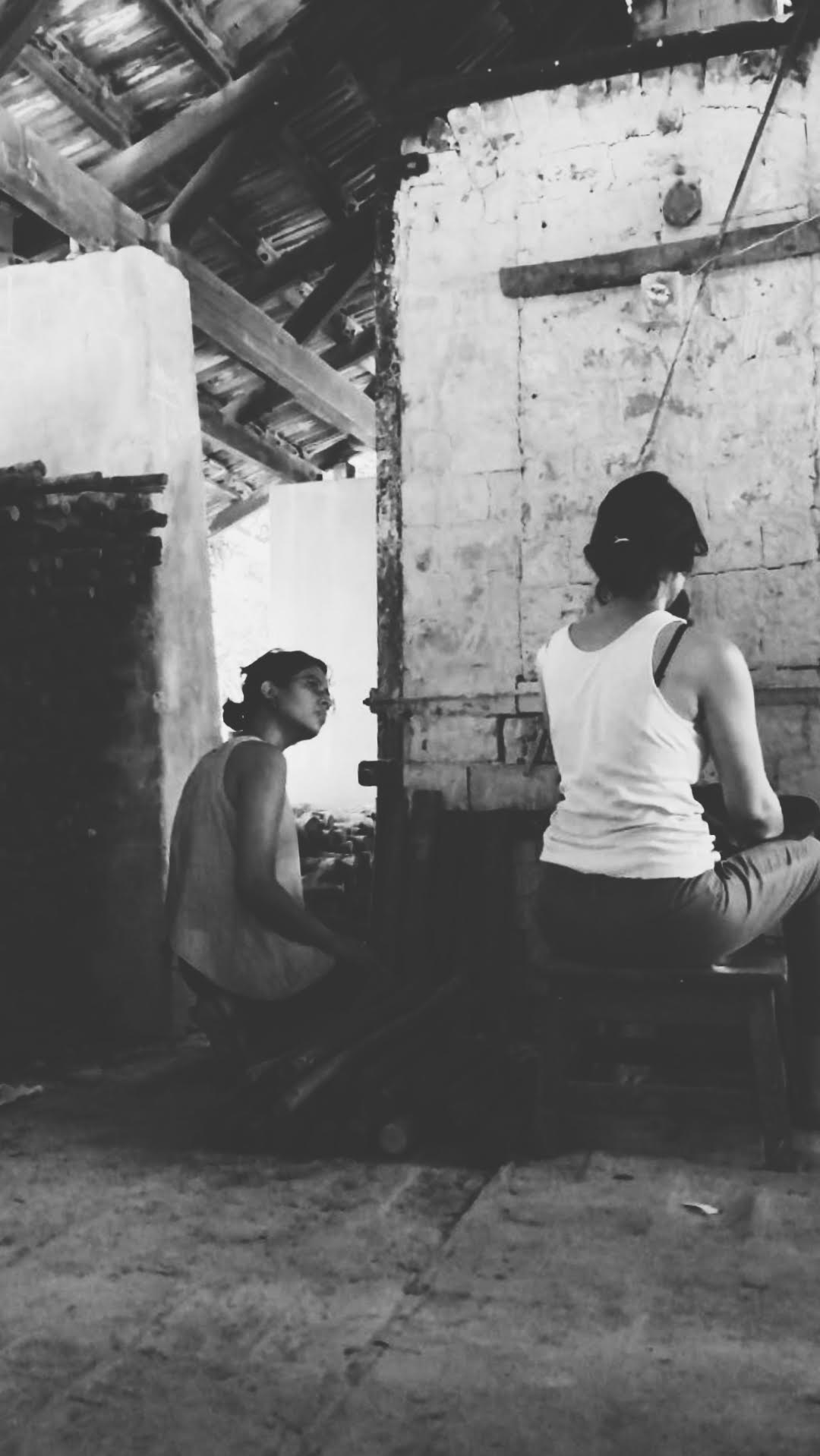 Drenched in sweat and covered in soot towards the end, we were only running on adrenaline. Everybody wanted to open the peeps to check the cones; we found it thrilling. Later, we intentionally monitored the peeps, trying hard for the bottom cones to go down. Finally, they did. We finished by late evening, mudded up the kiln, and gave a massive sigh of relief. We were exhausted, tired, sleepy, and yet excited to know what the kiln gods had in store for us. We had a day's break as the kiln cooled down, and we were to unload the next day. Brick by brick, row by row, we started unpacking. It was such an overwhelming feeling; we were all trying to get an early glimpse,
Drenched in sweat and covered in soot towards the end, we were only running on adrenaline. Everybody wanted to open the peeps to check the cones; we found it thrilling. Later, we intentionally monitored the peeps, trying hard for the bottom cones to go down. Finally, they did. We finished by late evening, mudded up the kiln, and gave a massive sigh of relief. We were exhausted, tired, sleepy, and yet excited to know what the kiln gods had in store for us. We had a day's break as the kiln cooled down, and we were to unload the next day. Brick by brick, row by row, we started unpacking. It was such an overwhelming feeling; we were all trying to get an early glimpse,
standing on stools, on our toes, and bending over with flashlights to see what it looked like inside. The door went down; that was our first glimpse at all the glazed pots. So many emotions flooded me: pure joy, contentment, and the satisfaction of a wholesome journey. We were so excited to have our pots out and be proud of them. These were not just pots, but an entire kiln's worth of memories. There was this sudden silence after a few moments of trying to contemplate and spend more time with the ceramic vessels; we felt this wave of "post-firing blues," as they call it. Debbie and Aarti, with all of us and our pots, gave their critique, helping us understand the firing better. I was mesmerized by how a vessel can tell you so much. This entire process was so fulfilling. I felt that fulfillment when I took one of the cups and thought back about how we spent days making the clay, struggling to get the form right, and here we were, seeing it come to life. There was immense joy and beauty in every bit of this process. Even the uncertainty that came along taught me to be accepting at every stage, which was one of the most important lessons I learned in my journey.
Soon we got back to our wheels, kickstarting the last leg of the course. We visited many studios around the time, looking at different works, conversing with artists, and being inspired. We were also taken to Ray and Debbie's house, which was heaven on earth for clay lovers.
We had two months before we fired the massive "Carla kiln" used for production. We started learning advanced forms and alteration techniques and were free to do our own explorations. We had a short, two-day hand-building workshop with Rakhee Kane, which opened many doors and opportunities, and gave us a fresh look at the endless potential clay has. These months flew by. Also, because we knew our time here was ending, we tried to make the most of everything. And soon, it was already time to plan our firing. We went through the whole process again, this time with a little more confidence. So many pots and stories hopped out of the kiln, officially marking our last day at GBP. It was a mixed soup of feelings. We knew our lives would change once we returned and were already missing our routine. Not having enough time to spend with our pots and each other, we all bid adieu, with a promise to keep in touch and to keep making pots. GBP gave me not only the necessary skills but also friends and companions for life. I owe this place and its people, and I hope someday I can give back with the same energy.
This phase of my life felt the most surreal. This place offered a philosophical reflection on the landscape of that time and place in my life. As much as it was about the material and the process – intensive and technical – it was about everything in between, the little things that the heart returns to again and again with moments that matter in our lifelong experience. You find yourself when you spend time by yourself. You build and battle thoughts. You become stronger with each passing day. My time here has truly changed my life. Living slowly, living within every moment, and living the life of clay. I am fortunate to have found this for myself. This journey has been the culmination of many lessons learned and the start of many more. I'm excited to continue this lifestyle, learn from masters, and fire with other amazing ceramic artists worldwide. Here's to understanding clay, everything in between, and continuously finding a path full of life and conversations.

